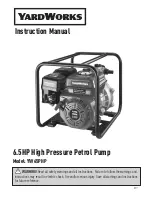
16
6.3 PUMP WARM UP
With inlet closed, pump warm up and thermal stabilization is achieved in 20-30 minutes. Warm up can be
expedited by operation in the 20-40 Torr (27-53 mbar a) range after an initial 5 minute operation with the
inlet closed. This can be accomplished with an inlet start purge or, if allowable, a controlled air bleed near
the inlet.
1. Check that the inlet isolation valve is closed.
2. Check that the vent valve is closed. Please note that if the pump was not vented when the pump was
stopped, the following procedure must be used:
a.) Remove power source from the pump.
b.) Remove belt guard from the pump.
c.) Rotate pump, in proper rotation, by hand using drive belts.
d.) Rotate at least 3 full rotations.
e.) Replace belt guard.
3. Start the pump.
4.
Open and adjust the cooling water flow as shown in the specifications.
5. Maintain oil level 3/8” up from bottom of sight glass when running at “Blank off” conditions (no gas
ballast). The circulating pump (Gear Pump) increases the oil pressure to 20 PSIG (1.4 bar), the check
valve will open and oil will be forced into the pump through the main line.
6. Adjust the Gas Ballast (See the
Gas Ballast
section). *The small gas ballast valve can be set to quiet
the pump during blank-off conditions and left open if an ultimate vacuum of .05 - .10 Torr (.7 – .13
mbar a) is acceptable.
7. Run the pump at blank off for 5-10 minutes and then with full gas ballast for 10-15 minutes before
opening the suction of the pump to the process by opening the inlet isolation valve.
6.4 PUMP SHUTDOWN
NOTE
Rapid reversal will result in premature failure.
NOTE
KT-series pumps must be properly vented during shut down to insure
normal startup conditions.
1. Close the inlet isolation valve.
2. Open the vent valve while the pump is still operating. If vent valve is not available use the large gas
ballast ball valve. Please note that the vent valve must be opened for at least ten seconds before
removing power from the pump. This will allow all the oil in the pumping chamber to be transferred into
the oil separator housing; so that it will not cause resistance to the internals on the next start up.
3. Close the large gas ballast valve.
4. Stop the pump.
5. Shut off cooling water.
6. Close the vent valve.
6.5 HANDLING LARGE QUANTITIES OF WATER
Use of the gas ballast valve enables Kinney pumps to handle small to moderate amounts of water and other
vapors in the suction gas stream. See the
Gas Ballast
section.
For applications where the vapor load exceeds that which can be handled by the gas ballast valve, consult
Tuthill Vacuum & Blower Systems about Vapor Handling Systems, which can usually be retrofitted to
existing pumps.
Содержание KINNEY 850D
Страница 29: ...29 NOTES ...
Страница 35: ...35 NOTES ...
















































